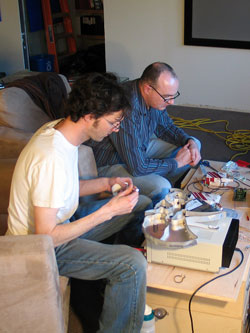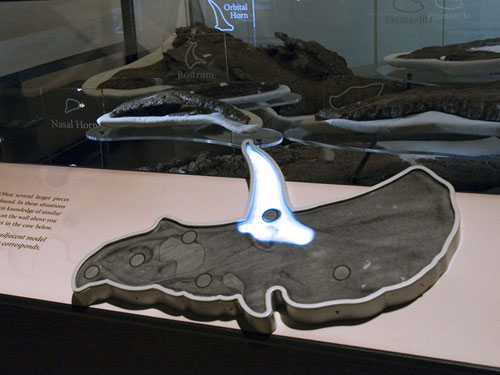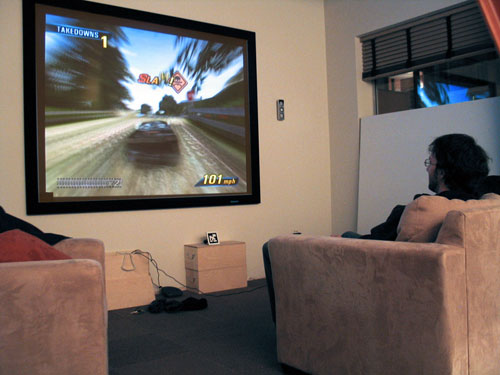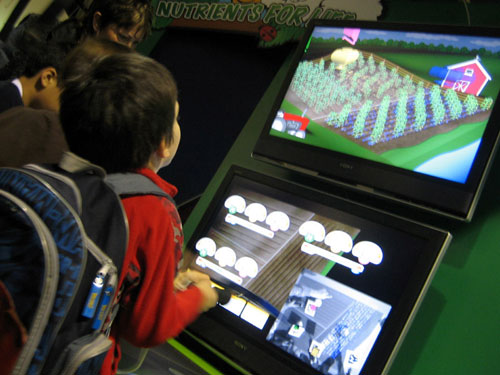Our latest installment of the New Founders Program puts the spotlight on EDM Studio, a Canadian design firm that creates cutting-edge content and software systems for museum-class installations. Their studio is a cross-disciplinary partnership between brothers Andrew and Darran Edmundson, melding architecture and 3D content design to produce an array of interactive science exhibits and projects.
Darran takes us inside EDM, to see what goes on when the brothers combine their ideas and expertise, how they manage their global network of subcontractors, and what they do to keep their business running smoothly.
How did you go from being a research physicist to what you’re doing now?
Mine is definitely one of those “right time, right place” stories. Back in 1998 I was a Canadian doing post-doctoral research in computational optics at the Australian National University. While CPU cycles on the physics unix system were rationed, it transpired that we were neighbours with the supercomputer facility. In addition to a large Fujitsu vector computer, the supercomputer facility had an advanced visualization group called Vizlab. For someone who has always had an affinity towards computer graphics and programming, this was nirvana: unfettered access to high-end software and a $250k SGI Onyx. By the end of my post-doc in 2000, I was probably spending more time in Vizlab than my department. And this occurred just as Vizlab needed an extra staffer to undertake some public VR projects. I ended up working on a number of museum exhibits, getting a full-time scientific visualization position in Vizlab, and eventually becoming an Australian citizen.
How did EDM come about? More specifically, how did you and your brother start a company and get to work on such a wide range of cool projects?

Vizlab’s specialty was computer graphics. For the museum projects, we’d provide cutting-edge content and the software systems to run it. Of
course, as anyone who has watched a feature film in a less-than-perfect theatre knows, the viewer experience can easily be degraded by the
environment. On a number of occasions we were let down by poorly designed physical spaces. Partnering with my brother Andrew, a Masters
in Architecture and burgeoning industrial designer, offered the opportunity to deliver a complete experience – compelling digital
content along with innovative design and physical fit-out. We constantly evaluate new technologies (augmented-reality, RFID, Wi-Max, motion-control mechatronics, mobile devices) with an eye to deploying them as part of 21st century exhibits. Indeed, we purposefully seek commissions that blend virtual and physical elements in new and interesting ways.
What’s it like to work on one of EDM’s installation projects?
Every project begins with a series of brainstorming sessions between the client and EDM Studio’s core team. Initially, ideas flow mostly from EDM’s side. However, as the client becomes increasingly informed about the myriad of digital, technical and interactivity options available, they quickly become active participants in generating exhibit ideas. EDM Studio’s experience allows us to keep these ideas within the realm of the practically achievable. By considering issues of cost, technology robustness, educational and entertainment value, visitor throughput requirements, space constraints, etc., one idea inevitably stands as worthy of further research.
As a first deliverable then, EDM Studio prepares a Development Plan, a comprehensive document that provides the client with a clear understanding of the exhibit as envisioned, the many reasons for the choices made, and the costs involved. The “as envisioned” part is important. EDM Studio believes strongly that good exhibits emerge as a result of iterative development. Creating an exhibit that entertains is relatively easy; creating an exhibit that achieves didactic goals is much harder. With this in mind, we ask for formal client sign-off on the Development Plan subject to the understanding that the plan will change based on continued feedback from test audiences. For this reason, EDM Studio projects typically involve an educational consultant whose job is to conduct user tests, both throughout development and post-installation.
Our production philosophy is a microcosm of the feature-film approach, namely, we begin with a project lead and his/her core group of technical and artistic directors, growing the team as necessary from among the global pool of available talent. We jokingly refer to this as the “Ocean’s Eleven approach to museum exhibits”. Some of these individuals and companies are local to Canada (primarily fabrication), but the bulk are distributed around the globe. The fact is, the chances of locating the best talent in one’s own region are negligible. EDM Studio has therefore committed a lot of effort to facilitating distributed teams. These teams represent an eclectic mix of skillsets, from real-time 3D programming to industrial mechatronics, from theatrical lighting specialists to graphic design. And while I’m wary to speak on behalf of others, the ability to work with such a diverse group of individuals is undoubtedly one of the main reasons that people enjoy working on EDM Studio projects.
Why do you need to track time, and how do you see Harvest help your business in that regard?
In the transition from institutional employee to small business partner, time management is a critical issue. There seems to be infinite demand for this finite commodity, whether it be project management, marketing, administration, R&D, or otherwise. Until you reliably track your hours, any decisions about ROI – and here investment is time – are just so much guesswork. What percentage of time did you spend marketing last year? That job that brought in $75k, did you end up working for $100/hour … or $25/hour? EDM Studio has been religiously tracking hours for the last year. We rely on this information to make informed decisions across all aspects of our business. For this reason we are transitioning to Harvest from an inferior (and thus best left anonymous) competitor. As time tracking is important to our success, we want a professional service that reflects this.
As museum projects typically run from 4-8 months in duration, it is very easy to start strong, ignore the middle, and then face a delivery crunch. Of course, sustained but incremental progress is a much more productive model. Time tracking lets us see at a glance which projects need attention.

Where do you see your business in one year?
Our aim is to expand out of regional Canada and undertake more international projects. This necessarily means larger-budget commissions with scope to really push some boundaries. Life is short … figure 2-3 projects per year over the next two decades. Knowing that we can only undertake 50 projects, we consciously try to make every one a portfolio piece.
What are some tools of trade you can’t live without (could be anything from a coffee mug to a software)?
In the 90s, one spoke of “the paperless office”. With Web 2.0 and our agile approach to project management using a global network of highly-talented subcontractors, we’re seeing huge benefits in moving our data out onto the internet. We use Basecamp for project management, Harvest for time-tracking, High-rise for contacts, IMAP for email, Google Calendar for appointments, LinkedIn for business networking, and Subversion for source-control. For computer animation, SideFX Houdini. For industrial design, SolidWorks. And python as our programming language (software glue) of choice.

What advice would you give to someone starting their business now?
Unless you are independently wealthy, get as much of the business foundation possible installed before leaving your current job. Spend your evenings, weekends and vacation finishing the business plan, launching the corporate web-site, prototyping your product, lining up clients or investment, etc.
If this is a full-time endeavour, you need to grow … fast. This precludes doing everything yourself. On every task you do, ask yourself if your time could be better spent elsewhere. In our experience, this “elsewhere” is likely marketing ;-)
Thanks, Darran! Find out more about EDM on their website.
